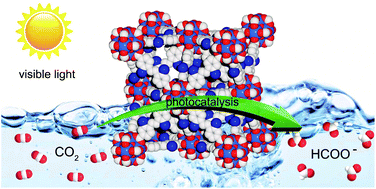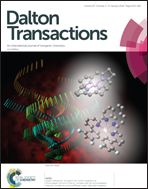Enhancement of visible-light-driven CO2 reduction performance using an amine-functionalized zirconium metal–organic framework†
Abstract
By employing a conjugated amine-functionalized dicarboxylic ligand (H2L = 2,2′-diamino-4,4′-stilbenedicarboxylic acid, H2SDCA-NH2), we have successfully synthesized and characterized a porous and visible light responsive zirconium metal–organic framework ([Zr6O4(OH)4(L)6]·8DMF, denoted as Zr-SDCA-NH2). This Zr-MOF showed good chemical stability and broad visible light absorption with an absorption edge at about 600 nm. When used as a photocatalyst, Zr-SDCA-NH2 exhibits visible-light activity for CO2 reduction with a formate formation rate of 96.2 μmol h−1 mmolMOF−1, which is higher than the series of reported amine-functionalized Zr-MOFs. Mott–Schottky measurements, photoluminescence study and photocatalytic experiments demonstrated that the Zr6 oxo cluster through the LMCT process and the organic ligand both contributed to the CO2 photoreduction. This study indicates that the combination of amino groups and highly conjugated molecules is a feasible and simple strategy to extend light absorption of the organic ligand, which is beneficial for designing a visible light responsive MOF photocatalyst.



 Please wait while we load your content...
Please wait while we load your content...